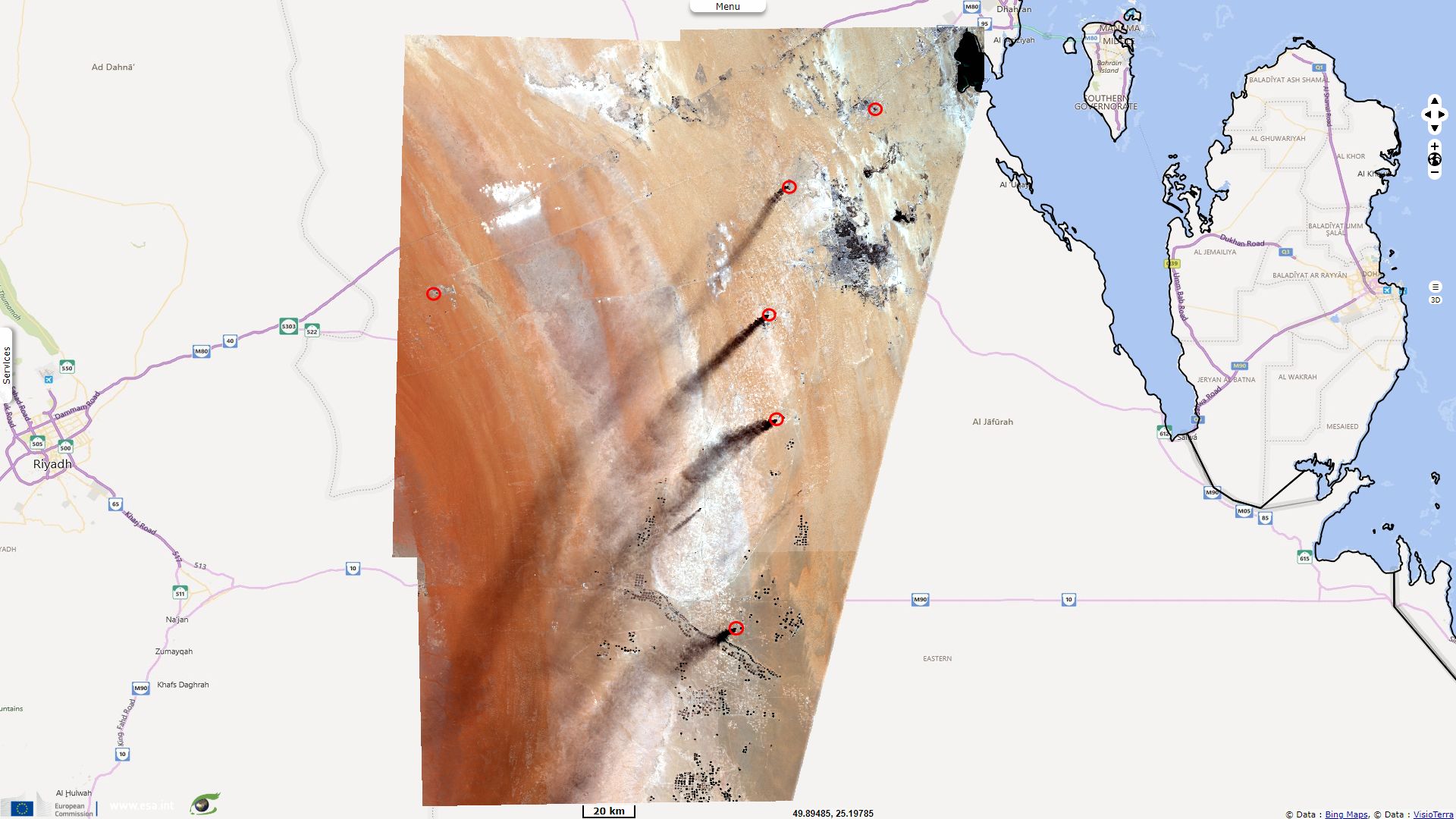Dark clouds hang over Saudi Arabia oil infrastructure
Sentinel-2 MSI acquired on 10 September 2019 at 07:16:21 UTC
Sentinel-3 OLCI FR & SLSTR RBT acquired on 14 September 2019 from 06:39:57 to 06:42:57 UTC
Sentinel-2 MSI acquired on 15 September 2019 at 07:16:19 UTC
...
Sentinel-2 MSI acquired on 30 September 2019 at 07:17:11 UTC
Sentinel-3 OLCI FR & SLSTR RBT acquired on 14 September 2019 from 06:39:57 to 06:42:57 UTC
Sentinel-2 MSI acquired on 15 September 2019 at 07:16:19 UTC
...
Sentinel-2 MSI acquired on 30 September 2019 at 07:17:11 UTC
Keyword(s): Land, fire, man-made disaster, atmosphere, pollution, greenhouse gas, oil field, infrastructure, Saudi Arabia
The Guardian reported: "Houthi rebels have claimed responsibility for a drone attack on the world’s largest oil processing facility in Saudi Arabia which is vital to global energy supplies. The attacks on the processor and a major oilfield, operated by Saudi Aramco, on early Saturday sparked a huge fire, the kingdom’s interior ministry said."
"According to Reuters, threes sources claimed the assault had disrupted output and exports, with one source claiming 5 million barrels per day of crude production had been impacted – nearly half the kingdom’s output. The fires began after the sites were targeted by drones, the interior ministry said in a statement carried by the state-run Saudi Press Agency. It said an investigation was under way."
The Khurais field, with an area of 2890 km² and 127 km long, is located about 250 km southwest of Dhahran and 150 km east-northeast of Riyadh, its exploitation started in 1963. "The Khurais oil field is thought to produce more than 1m barrels of crude a day. It has estimated reserves of more than 20bn barrels, according to Saudi Aramco. It describes its Abqaiq facility as the largest crude oil stabilisation plant in the world. It is thought to be able to process up to 7m barrels of crude a day."
Saudi Arabia officially has about 260 billion barrels of oil reserves, comprising about one-fifth of the world's proven total petroleum reserves and the country is the World's largest exporter of petroleum. It also has the fifth-largest proven natural gas reserves. Roughly 63% of Saudi Arabia's budget revenues, 67% of its export earnings and 45% of its nominal gross domestic product come from the oil industry. These attacks happen in a context of the Initial Public Offering of a fraction of the Saudi national oil company Saudi Aramco. CNBC published: "Reuters reported last week that the kingdom plans to list 1% of Aramco on its local stock exchange before the end of this year and another 1% in 2020, as first steps ahead of a public sale of roughly 5% of the company."
"The oil giant has delayed its IPO, originally scheduled for 2018, reportedly over Saudi concerns about public scrutiny of its finances and because of the complexity of its corporate structure. Crown Prince Mohammed has touted a valuation of as high as $2 trillion, while a number of bankers recommend a figure closer to $1.5 trillion. The oil price will be key to this."
"Saudi Aramco CEO Amin Nasser told the media just that the mammoth company would list on the Riyadh stock exchange “very soon” as bankers from J.P. Morgan, Goldman Sachs, Credit Suisse and Citigroup met in Dubai to kick-start work on the gigantic offering."
However, the plan could be further differed: "News of the weekend attack sent money streaming into safe haven assets Monday morning, and industry experts questioned the security of Aramco’s assets and the confidence of its future shareholders."
A transition toward abundant solar energy could alleviate the Saudi dependency on oil and gas ressources as well as reduce its greenhouse gas emissions but the kingdom remains quite cautious. Ahead of COP21 in Paris, Andrea Barolini wrote in LifeGate: "It’s very important that a nation that grounds its wealth on oil extraction has declared its will to fight climate change. It’s likely that the country dreaded a diplomatic isolation on environmental issues, considering that 157 countries (out of 195) submitted their pledges in view of the COP21 (Saudi Arabia has become the last country of the G20 to submit its national climate plan)."
"However, from an 'ecological' perspective, the decision is important but not particularly decisive. The country is responsible for 1.2% of global emissions (equal to Italy, according to data published by the World Resources Institute in 2014). The real paradox is the fact that Saudi Arabia also stressed that its pledge is dependent on a diversified economy and a “robust” oil export revenues over the coming decades, as well as that it “reserves the right” to update its plan."
"According to Célia Gautier of the NGO Climate Action Network, as reported by the news agency AFP, Saudi Arabia has understood that a global transition towards renewables is unavoidable. However, it’s difficult to say if the country will accept such process aimed at giving up on fossil fuels (oil, gas, and coal) by 2050. Yet, it would be a mere strategic choice, since Saudi Arabia’s potential is undeniably huge, in terms of renewable energies exploitation."
The United States and Saudi Arabia rank last when it comes to curbing climate change among the 56 nations accounting for 90 percent of planet-warming greenhouse gas emissions, researchers said during the Katowice UN Climate Change conference (COP24).














